Would you like to see this aircraft added to the game?
Where should this aircraft be placed?
- Israeli TT
- Future Argentine TT
- Other
- I answered no to the first question.
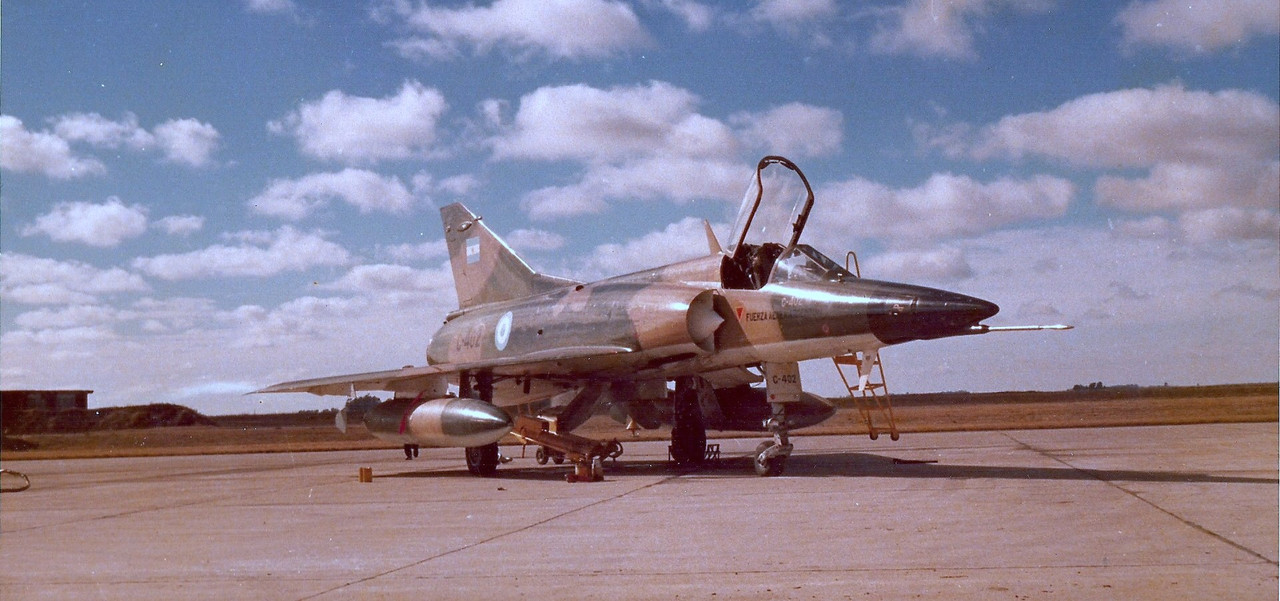
An introduction:
Today, we’ll be taking a look at the IAI Dagger, the Argentine designation of the IAI Nesher, the Argentine air force adopted this aircraft at the brink of a possible war with Chile (known as the Beagle crisis) but ended up using them during the 1982 Malvinas war with the United Kingdom, there the aircraft was used mostly in the attacker role against British ships and land targets. The aircraft itself doesn’t change much from the original Israeli configuration, but there are certain things that make it apart.
History and Service:
Ill be covering the Argentine side of the story, since the Nesher had its own suggestion explaining its own story.
Beagle crisis and the requirement for more fighters:
The initial requirement dates back to the 1960s, by this time the Argentine Air Force was undergoing a mayor change in equipment, old and obsolete aircraft like the Gloster Meteors gave place to the brand new mirage IIIEAs or the Avro Lincolns and Lancasters were replaced by Canberras, among other purchases made. The choice to go with the French mirage III would eventually play a big part on the decision to purchase the Dagger, given that they shared a similar logistical chain, engines and required the same level of expertise and training to field, crew and maintain.
During the 60s & 70s the relations between Chile and Argentina would see clashes regarding the definition of borders, with the US and UK failing to act as mediators until the late 70s. As time passed, both countries would make provocative demonstrations of sovereignty over the disputed land, with cases ending on firefights or aggressive operations to capture and secure the disputed land. In 1976 a coup in Argentina removed the democratic government of Maria Estela Martinez, with the justification of inaction on the multiple insurgencies and small conflicts across the country, the new de-facto government would be subjected to a military embargo by the United States (this Embargo was also applied to the Chilean Junta) with the intent of stopping any type of aggression by both countries. This embargo stopped the works by the FAA to buy a new aircraft for the attacker role, as any US made planes were prohibited (More capable A-4s, F-5 Tiger, etc.), France would also negate a sale of Mirage V fighter-bombers after being pressured by the US. Almost out of conventional options, Argentine officials approached Israel, in efforts of getting the New and Impressive Kfir C.2, but due to it having an American made engine it was discarded. The Israeli Government offered a deal that would finally be something that the FAA was looking for…The Nesher…
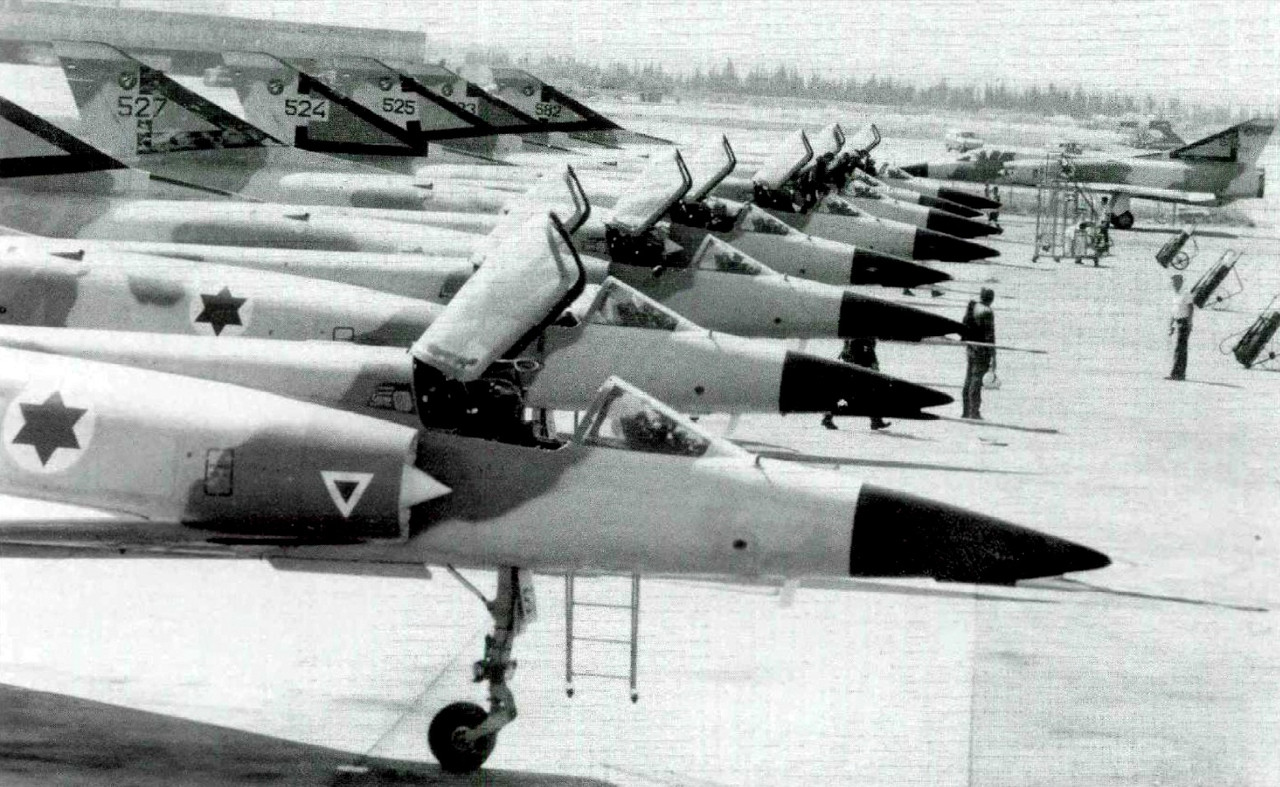
IAF Neshers during their service with the IAF
The Nesher was an Israeli development of the Mirage 5, although relatively similar, it had some notable differences in its electronics and a strange functionality that made it more maneuverable moving the center of gravity backwards as it emptied one of its internal fuel tanks first and then the external ones. The initial Israeli deal was conformed by 24 single seat and 2 2-seater Nesher T, with the proposal of converting this aircraft to a standard similar to the one found on the Kfir C.2s. After the failure of the royal mediation for the proper designation of borders (where the Queen of England decided to favor Chile) the Argentine Government deemed the arbitrary invalid and relations with Chile worsened. The deal of the Nesher was immediately taken in 1978, as the relations with the neighboring country disintegrated, Argentine Pilots were sent to Israel and Peru (who operated Mirage Vs) to become at least achieve combat standards (250-500 Flight hours), while also at the same time IAI worked no-stop trying to get all aircraft ready for delivery.
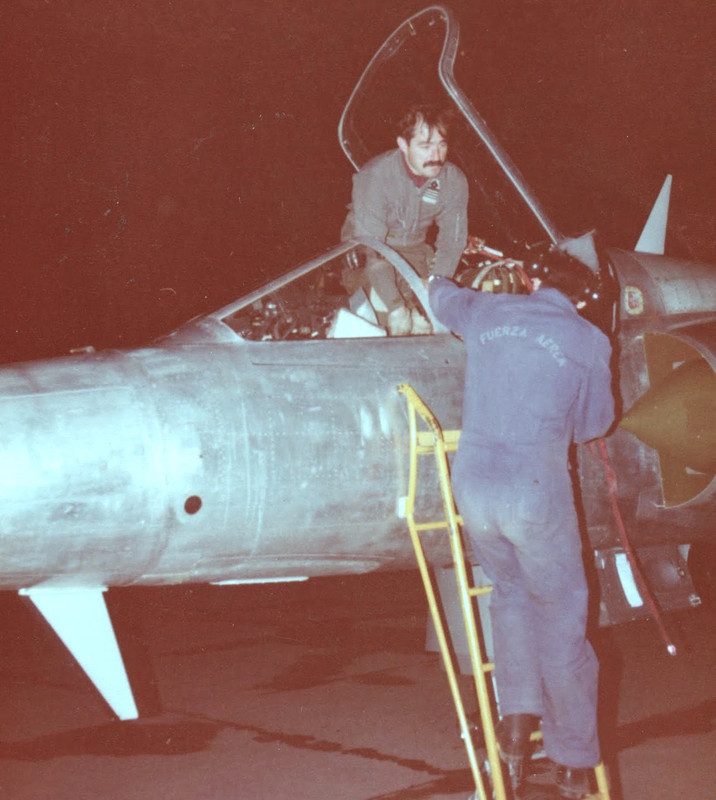
Pilot exits an unpainted dagger while they were prepared to be inducted into Argentine service during the crisis in 1978
The aircraft were delivered via ship in small batches, all done as fast as possible, as movements done by Argentine and Chilean forces were starting to show desperate signs of an imminent war. Some of the aircraft arrived with the wrong paint, were stripped of it and painted on Argentine bases, while also only test flown during the night to avoid being detected by any type of Aerial surveillance (planes or Satellite). Thanks to the Pope intervention, this “almost conflict” was forced to “cool off”…the Neshers would finish their delivery in 1979. Upon entering service, this would be renamed “Dagger”.

Daggers being received from Israel bearing the SEA livery
The war of the South Atlantic.
The morning of the 2nd of April 1982 would surprise the Dagger squadron with the news of the retake of the Malvinas islands, time after the situation was made known in the VI brigade, almost all IAI Daggers were prepared and later deployed south in the form of mobile “squadrons”. All with the objective of supporting operations on the islands and to repel any British or Chilean incursions, this “mobile squadrons” were known as:
- 1st Aeromovil Squadron/BAM Tandil (Buenos Aires)
- 2nd Aeromovil Squadron “La Marinette”/BAM San Julian (Santa Cruz)
- 3rd Aeromovil Squadron “Avutardas Salvajes”/BAM Río Grande (Tierra del Fuego)
We will take a look into each squadron actions during the war:
The first Aeromovil Squadron was assigned to a secondary role, this was to provide proper training for pilots that were recently finishing the course for this plane, or for pilots that had lost their coalification due to being assigned to another aircraft or other issues. This squadron would see itself being equipped with 4 aircraft, 1 single seater and 4 Nesher/Dagger Ts for training, although towards the end of the War, this squadron received the first Examples of the Mirage VPs that the Peruvian government donated for the War effort, although this machines never got to operate in the war.

Deployed in the Patagonia
The 2nd squadron known as "La Marinete ‘’ was initially established the 2 of April in San Julian (Santa Cruz), initially integrated by 5 aircraft, but with more numbers adding themselves as the squadron got accustomed to the base. The first operations against British forces would take place the 1st of May, when 2 formations belonging to this squadron would scramble, one with AAMs and the other with bombs in efforts of engaging both British Aircraft and Ships. While one formation provided aerial cover, the other located and attacked a formation of British ships that were bombarding Argentine positions, 3 ships would be hit by cannon fire (HMS Arrow, HMS Alacrity and HMS Glamorgan ) but only one of this would suffer close damage by the explosion of 250kg bombs (HMS Glamorgan), this forced the ships to cease their bombardment and retreat. After this a PAC of 2 Sea Harriers would arrive to intercept the fleeing attackers, immediately a formation of 2 Daggers would also arrive to defend their comrades, after both formations got in close, the harriers desisted their pursuit and refused to engage the Daggers, while the Argentine aircraft did the same.
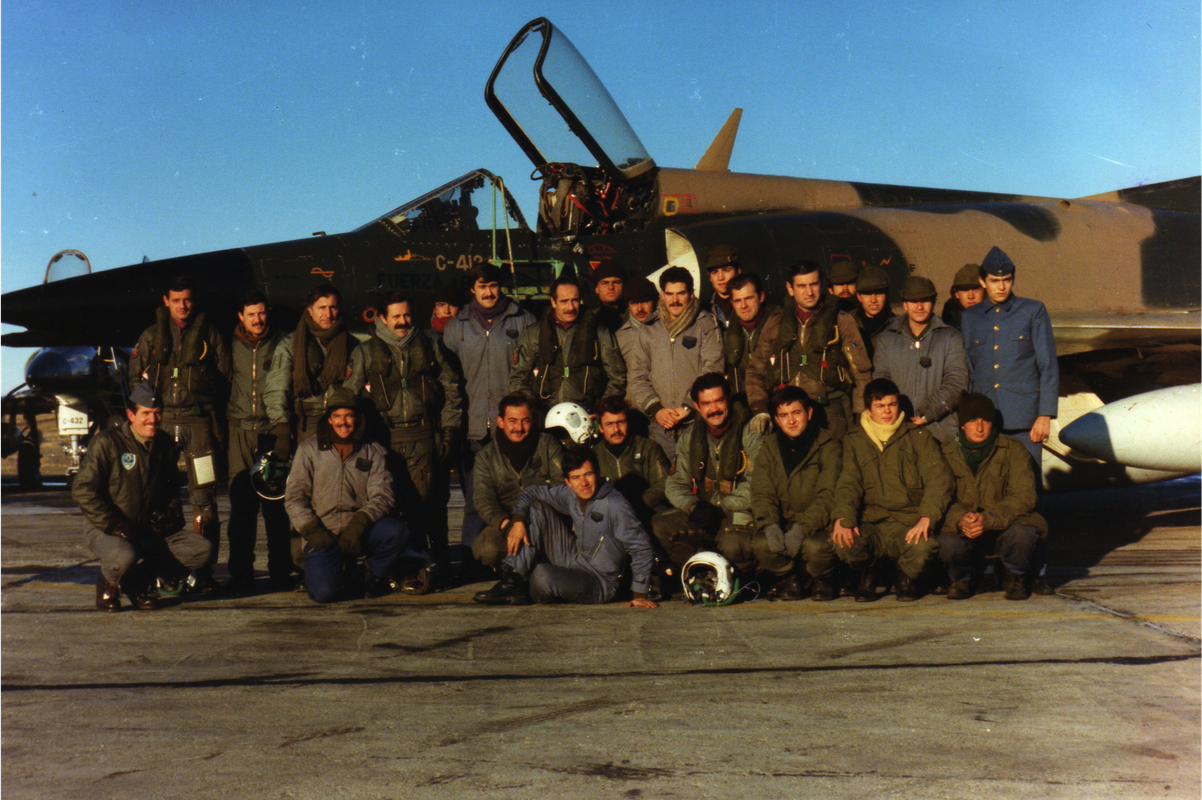
Personnel of the 2nd Aeromovil Squadron
The 2nd of may, the first reinforcements would arrive in the form of 2 more daggers (total number of 9), from this point on, bad weather conditions would neglect most missions while in others, the targets simply couldn’t be found. Until May 21st, where the 2nd squadron would endure its most intense moment during the campaign. A total of 4 formations were scrambled during the morning, “Leon” tasked with attacking ships, engaged with HMS Antrim that was just moments before was attacked by the 3rd squadron, this attack would score a hit in the rear of the ship setting the Sea Slug Magazine on fire and making it abandon the combat zone. The second formation named “Zorro” would engage HMS Brilliant, while the bombs of this formation would not hit, the ship was subjected to cannon damage. The third known as “Laucha” would take off along the 4th “Raton”, and like the second formation, they attacked HMS Brilliant, this time the cannon damage would be severe in the control room this required the ship to be retired from the combat zone for some time until it was fixed. The fourth formation wouldn’t be able to attack as it was intercepted by a PAC of Sea Harriers, all 3 Daggers would be shot down, its pilots would eject safely.
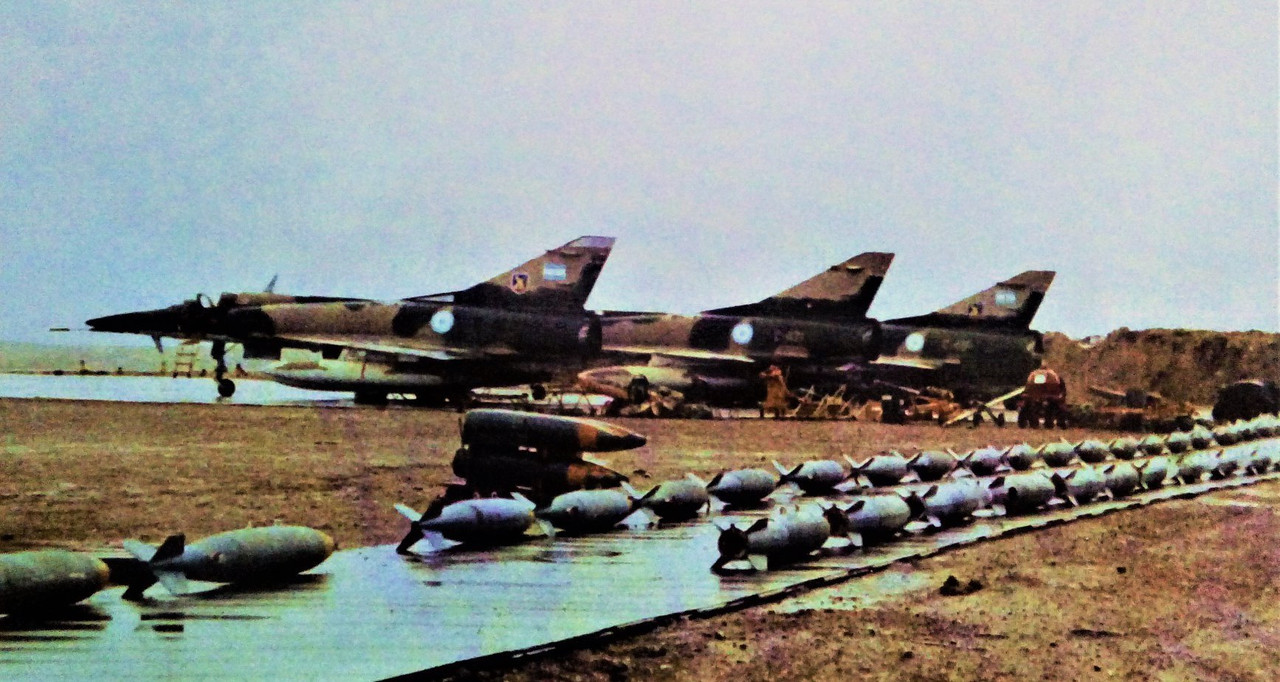
Daggers on Stand-by, quite a selection of bombs can be seen
The 24 of may would see more incursions against the massive British landings, 2 formations “Plata” and “Oro”, with the latter being intercepted by a PAC of Sea Harriers after attacking a type 21 frigate, losing 3 aircraft and one pilot. At the same time "Plata ‘’ would engage under extremely heavy AA fire, this would result in their aim being inaccurate with only one bomb detonating fuel tanks on the shore. Later on May 26 a new attack under the “Poker” formation would attack for the first time with bombs that had an electronic fuse, this was done as the area to attack was covered by fog, the Argentine radar on the islands directed the bombing.
On May 29th a new attack against land forces was sent out, the “Patria” formation would not accomplish this attack after encountering bad weather conditions. A second and third attack by the formations “Leon” and “Puma” were sent with little effect, no Daggers were lost.
By the 1st of June, the Squadron would homologate and test 500kg bombs, and from this point on, the II squadron would only concentrate in attacks towards British Land forces in efforts of helping the Army defend the islands. These operations would begin with an attack on Mount Kent the same day using 250kg bombs, while the next day the “nene” formation would be sent to engage, but after bad weather conditions it was ordered to retreat.
The operations that took place on the 8th of June saw the Second squadron doing a secondary role, where it saw all of its aircraft being scrambled in 2 formations “Carta” and “Sobre” that were used to distract the PAC of Harriers while the other squadrons were attacking British forces in Bluff Cove. As days passed the squadron would test the Argentine made EXOCOR 125kg bombs, while also receiving Peruvian personnel for the entry to service of the Mirage VPs recently donated by the Peruvian Government. After 2 missions targeting Mount Longdon failed due to encountering a PAC of Sea Harriers and failure to locate the Objective, the second squadron was retreated to BAM Tandil and ceasing operations in the South Atlantic. The “Marinete” Squadron managed to launch a total of 84 bombs while also firing 2920 rounds of 30mm cannon, while damaging 5 ships.
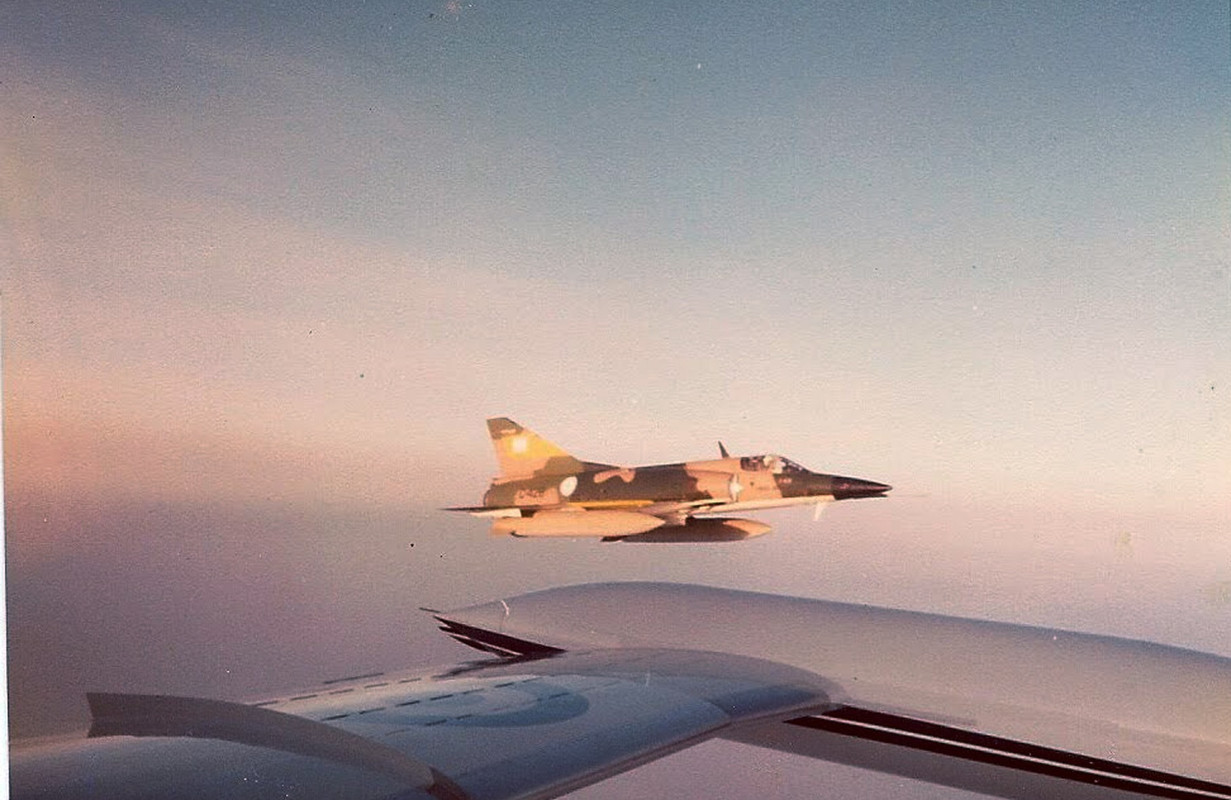
A squad of Daggers being guided by a Lear jet of the Fenix squadron, given the simplistic navigation instruments on the Daggers, aircraft with more sophisticated ones were often required to help with guidance towards their objective.
The Third Aeromovil Squadron known as “Avutardas Salvajes” was created the 6th of April in Rio Grande (Tierra del Fuego province), initially formed by 8 Daggers, this squadron would initially be involved in training with an Argentine Navy SP-2H Neptune and later with the Super Etendards with mixed results. Much like the 2nd squadron, the first combat operation took place the first of May, when 4 Formations were seen scrambled during the day, the first 3 would encounter no enemies or issues, the forth called for 2 Daggers in AA configuration, one of the 2 couldn’t take off after having problems with its engine, while the other continued on alone. While over the islands the lone Dagger commanded by 1st Lt. Adrilles would encounter 2 harriers that came for him, position himself behind one and launch a Shafrir AAM what was evaded by the Harrier after using Flares, unknown to Ardiles, another Harrier behind him launched an AIM-9L that destroyed his aircraft, Ardilles losing his life, This was the first loss recorded by the Third squadron.
For a week the third squadron would be tasked with doing aerial cover missions, with major participation on the covering of the Super Etendard mission that sank HMS Sheffield and to cover a Fleeing SP-2H Neptune that was being closed in by a PAC of Sea Harriers.
The 6th of May the squadron would plan their first attack missions arming the Daggers with 1000lb bombs, although bad weather postponed these plans. Days later two formations would take to the skies to provide “decoy flights” to deceive the SH PACs into chasing the Daggers with none being intercepted by enemy aircraft.
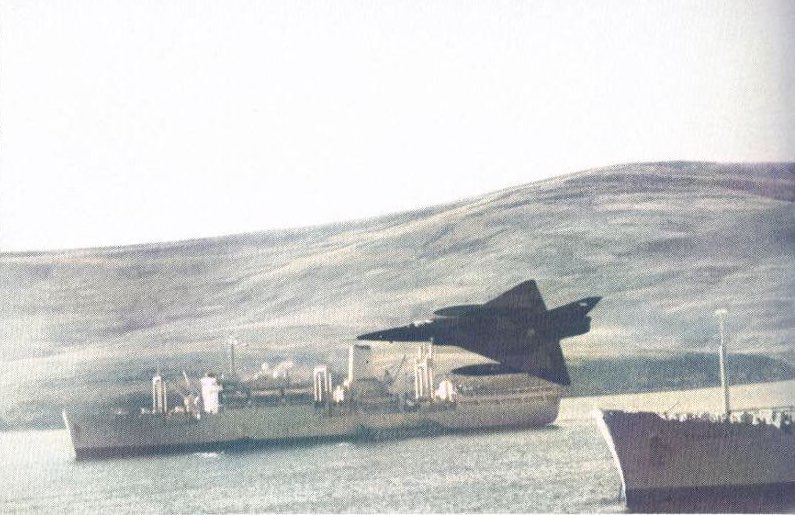
A dagger flying pass a British vessel
On may 21st while the British Landing was taking place, a formation was scrambled to attack, the Daggers would engage HMS Broadsword with only cannon fire provoking minor damage and wounding various sailors, one of the Daggers was shot down by a Sea Wolf missile during its escape. At the same time another formation “Perro” stumbled across HMS Antrim that was immediately attacked by the Daggers, the ship was hit by unexploded ordinance and forced to leave the combat zone for some time. During their escape a PAC of Harriers scrambled towards them, but they were outrunned by the Daggers.
During the afternoon 2 more formations were sent to attack surface ships, this two were detected by a ship before arriving to their destination, a PAC of Sea Harriers were scrambled and managed to locate the Daggers, one of which was shot down by an AIM-9L (1st Lt.Luna ejected), the Harriers retreated afterwards. The rest of the formations continued towards their objective, upon arriving they found HMS Ardent who was bombarding Argentine positions on BAM Condor, the daggers attacked with 1000lb bombs hitting the stern, tearing the Sea Lynx helicopter apart and blowing up the Sea Cat missile launcher. The ship’s flooding was controlled while it slowly retreated, but it got attacked by Navy A-4Qs that eventually sank her.
The Daggers would take to the skies again on May 23rd, where 2 formations were ordered to engage a surface vessel around San Carlos, the mission would be cancelled after proper contact with the guidance aircraft couldn’t be established. Another 2 were also sent, the last of which was intercepted by Sea Harriers, losing one aircraft and its pilot (Lt. Volponi) as he couldn’t eject. Within the Next day, more formations would engage British ships, with “Azul ‘’ dropping 1000 lb bombs over RFA “Sir Bedivere ‘’ with minor effect, while another 2 formations were sent to attack a radar station that unfortunately could be found.
By May 28th, a formation known as “Poker” composed by 4 aircraft were sent to attack ships north of the San Carlos straight; one of the Daggers was shot down by SAM while on route, its pilot Lt. Bernhardt lost his life). For some time, operations would be lowered as the squadron had lost 5 aircraft and their respective pilots, and they awaited replacements. But on the 8th of June, the IIIrd squadron would again take to the skies to attack British forces on Bluff cove, the 2 formations “Perro” & “Gato” would encounter and engage HMS Plymouth, their Mk.82 bombs would fail to detonate, but they provoked a fire inside the ship that would leave it permanently out of action for the remainder of the conflict.
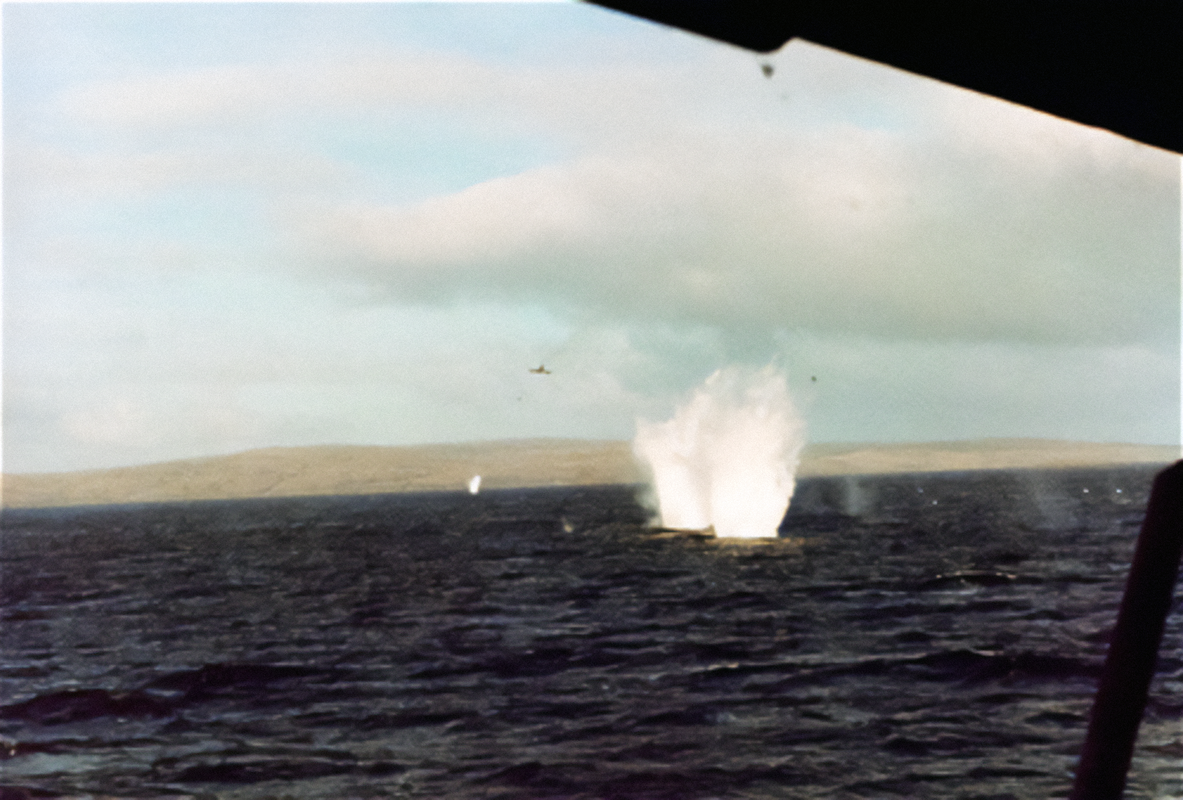
A Dagger photographed from HMS Plymouth while under attack
After an unsuccessful mission on the 9th of June, the IIIrd Squadron was retained in the zone even after the end of the conflict until the 19th of June when it was sent back to Tandil.
As the hostilities ceased, the aircraft returned and were inspected to repair most of the stress suffered on the war, with also the resuming of the program that regarded the upgrade of their systems (AKA the SINT or Finger program). With time passing the Daggers would homologate various systems to increase their survivability (Flares+Chaff & RWR), with later most of the type being upgraded or used as spares for the fleet.

A Dagger fitted with Countermeasures
As the Finger program upgraded most airframes, the number of original Dagger reduced until none were left in operational status.
Specifications:
Spoiler
Crew: 1
Dimensions:
Length: 15.61 m
Wingspan: 8.22 m
Height: 4.55 m
Wing Surface: 34.80 m²
Weight:
Empty weight: 6800 kg
Max takeoff weight: 13500 kg
Engine: Bet Smersh/ SNECMA Atar 9C-5
Power: 9370 Lbf of thrust (normal), 14000 Lbf (Afterburner)
Performance:
Max speed: 1400 Km/h (Sea level)/Up to Mach 2.0+ At higher altitudes.
Service ceiling: 18000 m
Climb-rate: 186 m/s
Range: 1250 Km (Combat)
Armament:
Spoiler
Internal Guns: x2 DEFA 552 30mm cannons (125 RPG)
A total of x7 Hard-points to carry:
- 1000lb bombs (Mk.17)
- 250kg bombs (Expal BK/BR, with or W/o parachute)
- 130kg bombs (IMI)
- 125Kg bombs (general Purpose/EXOCOR)
- 115Kg bombs (IMI)
- LAU-60 Rocket pods (FFAR)
- LAU-10 Rocket pods (ZUNI)
- Shafrir 2 Mk.4 AAMs
Visualization:
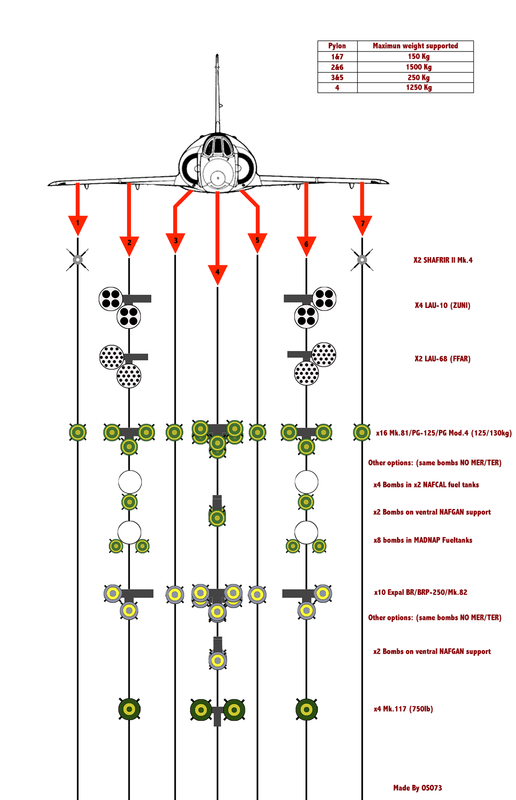
Pay in mind, that this is just a representation of some of the Armament configurations the Dagger could carry, if more is discovered, it will be updated, but its main purpose is to give a better idea of some of the presets used.
Other Systems:
- CHAFF/FLARES (fitted in the space for the SEPR rocket)
- RWR
Images:
Spoiler
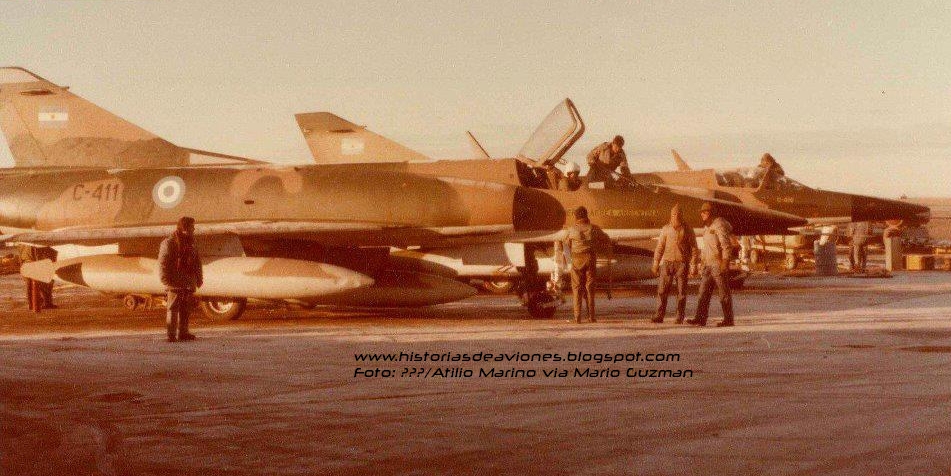
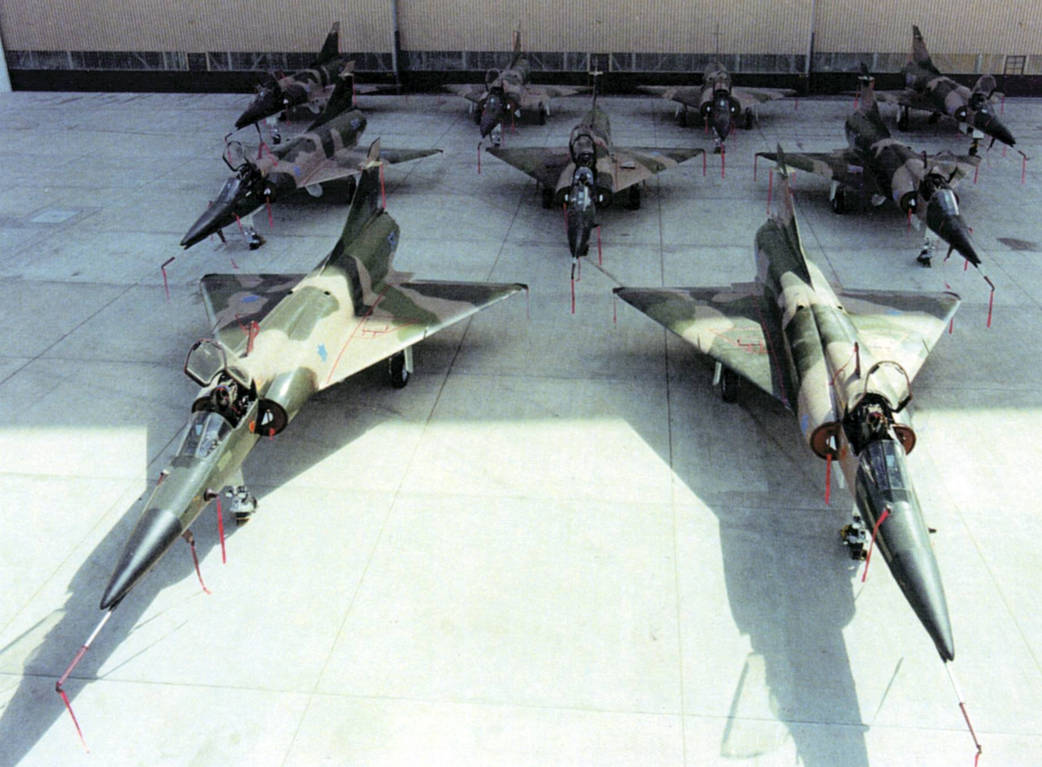
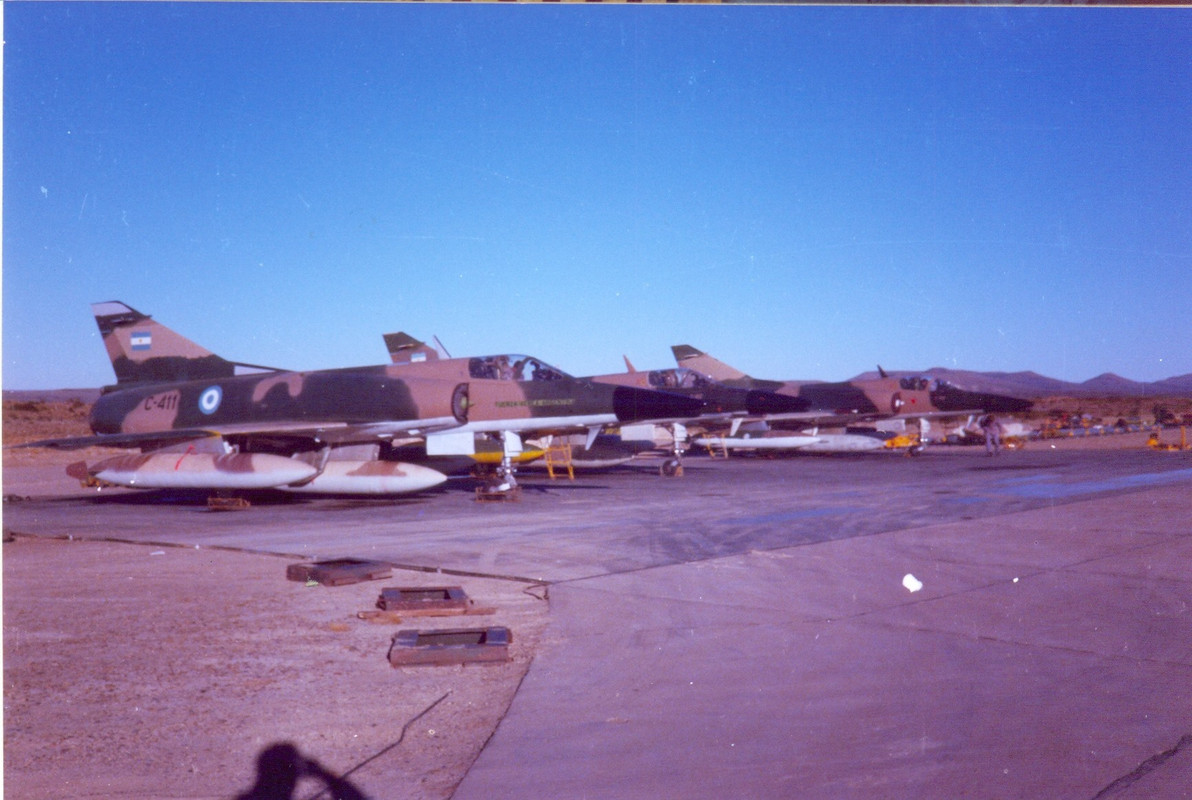
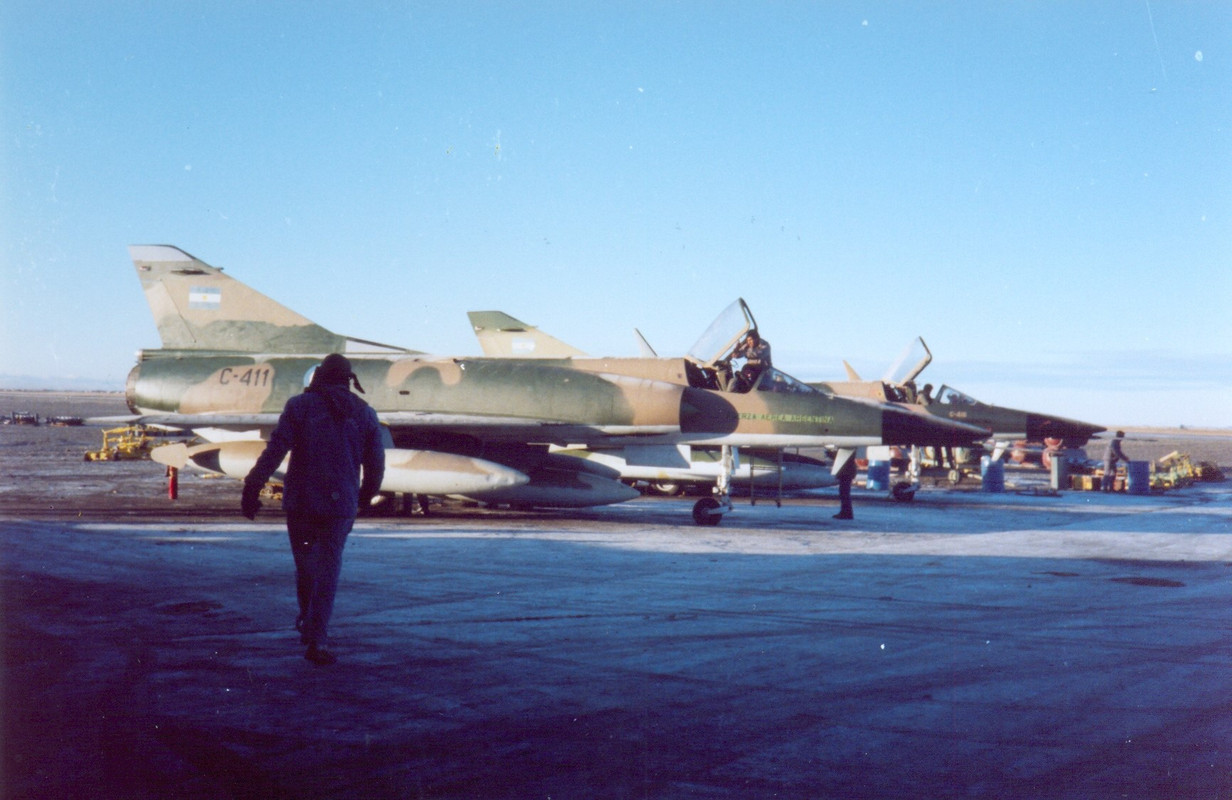

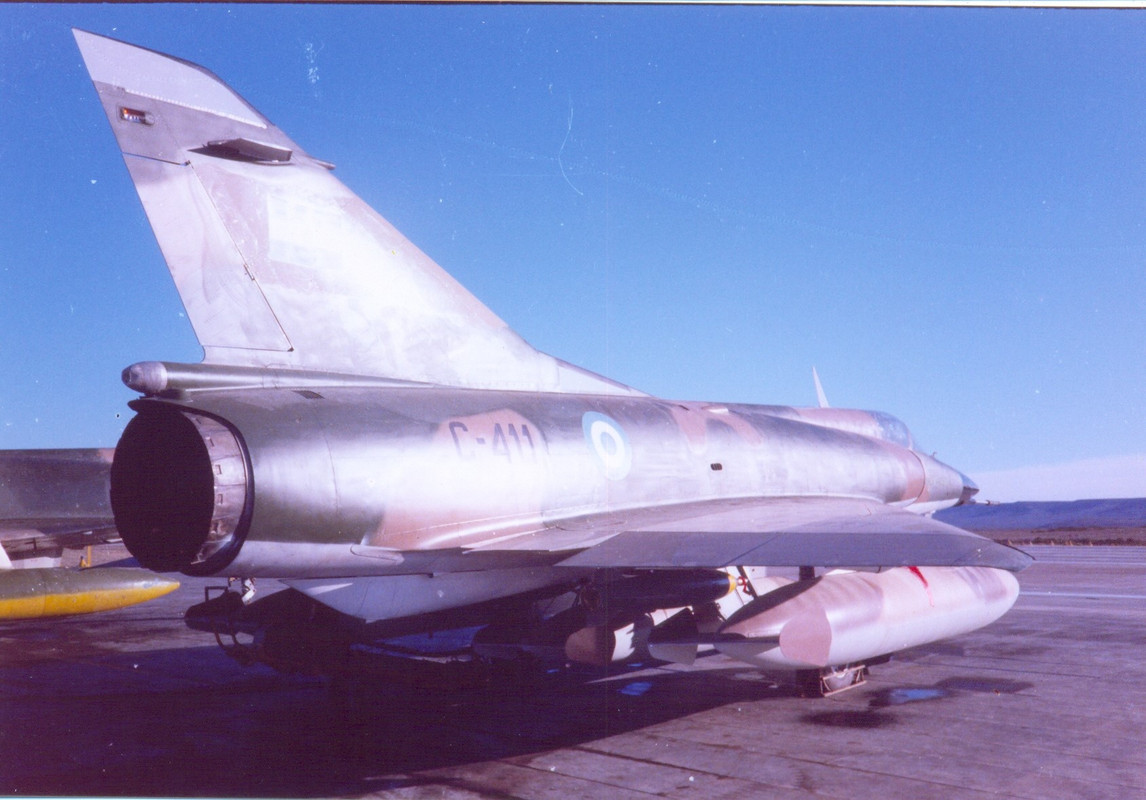
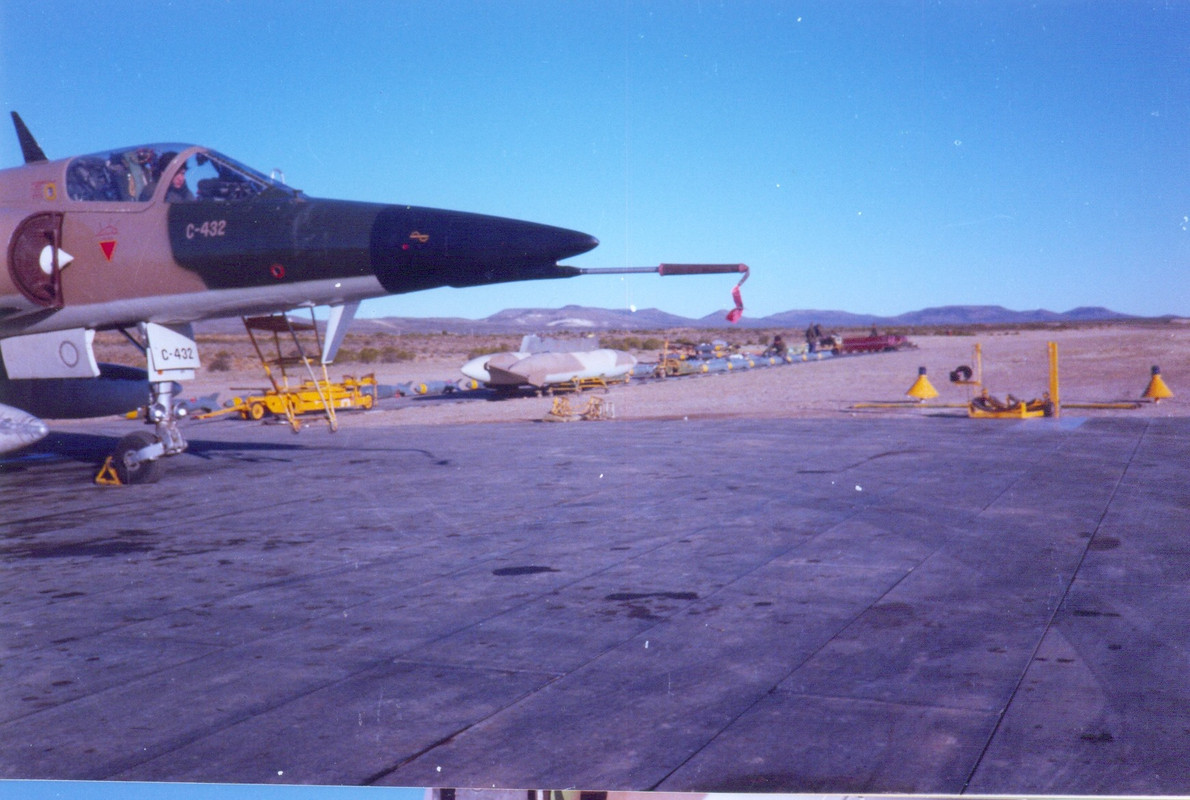

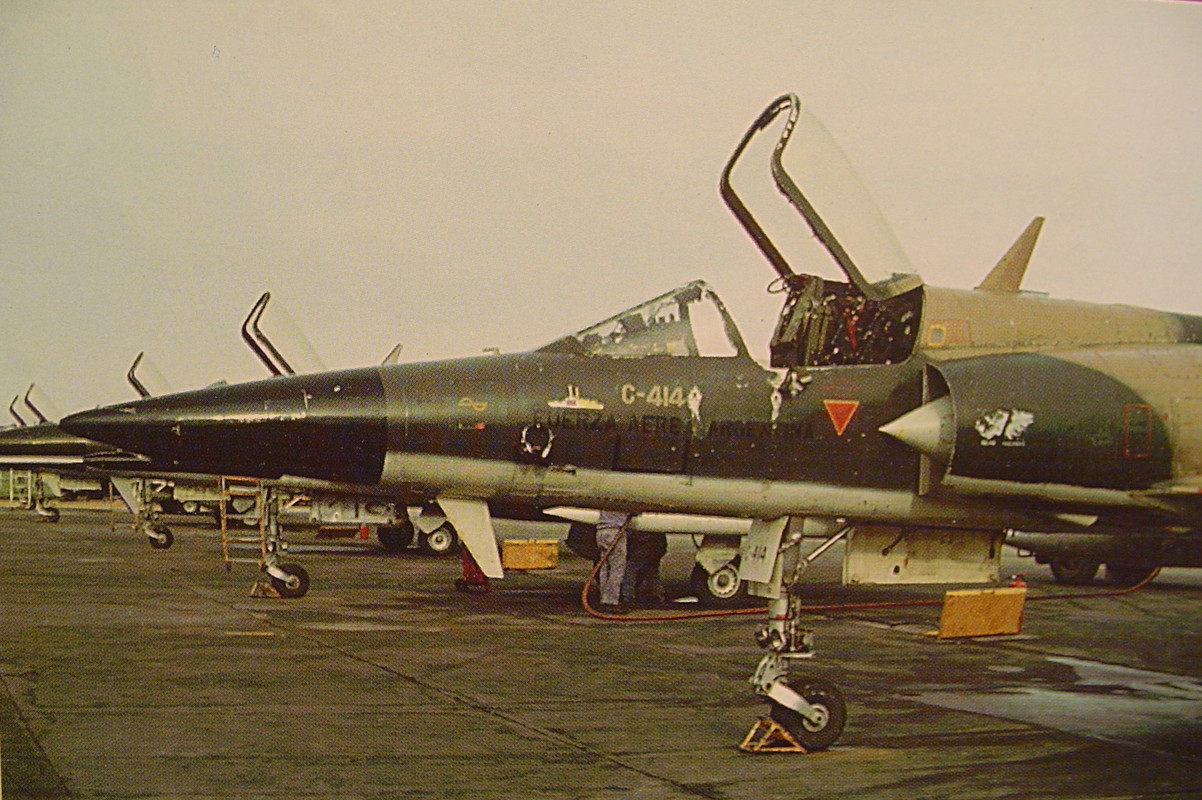
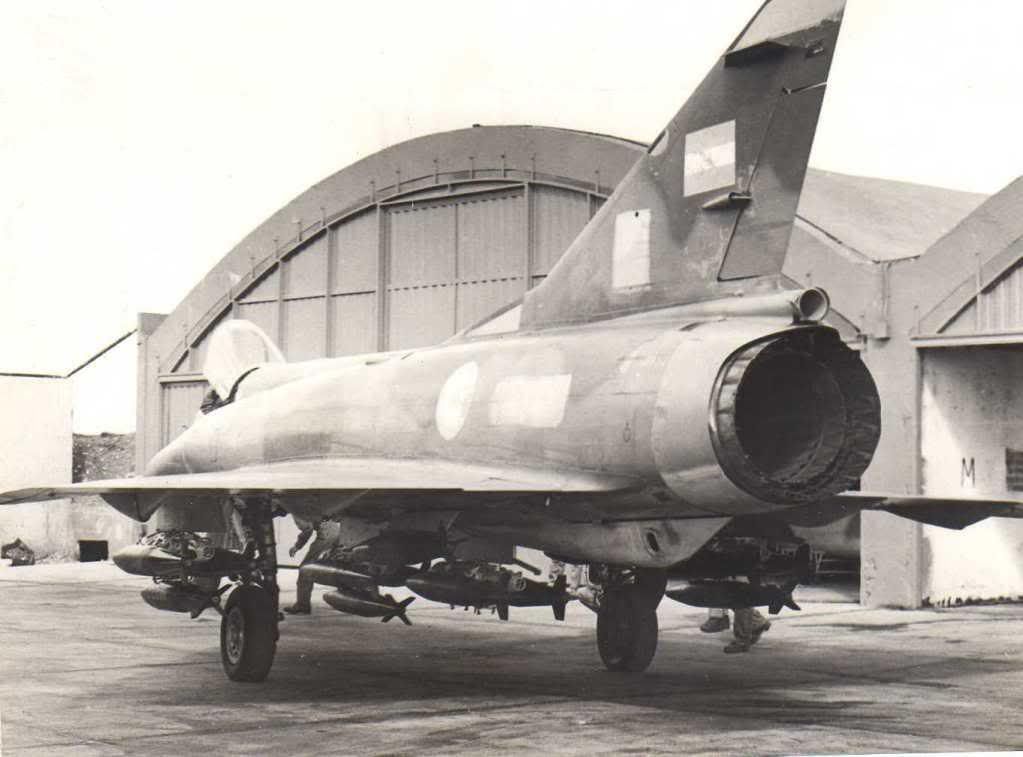


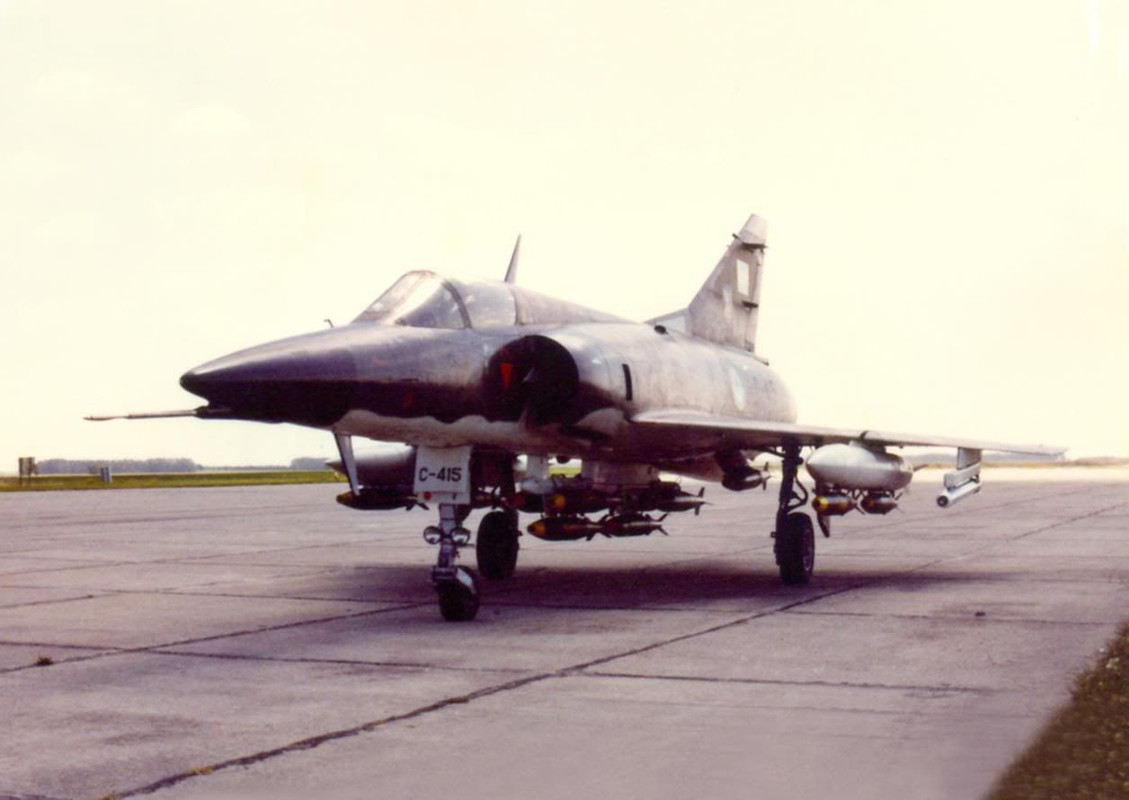
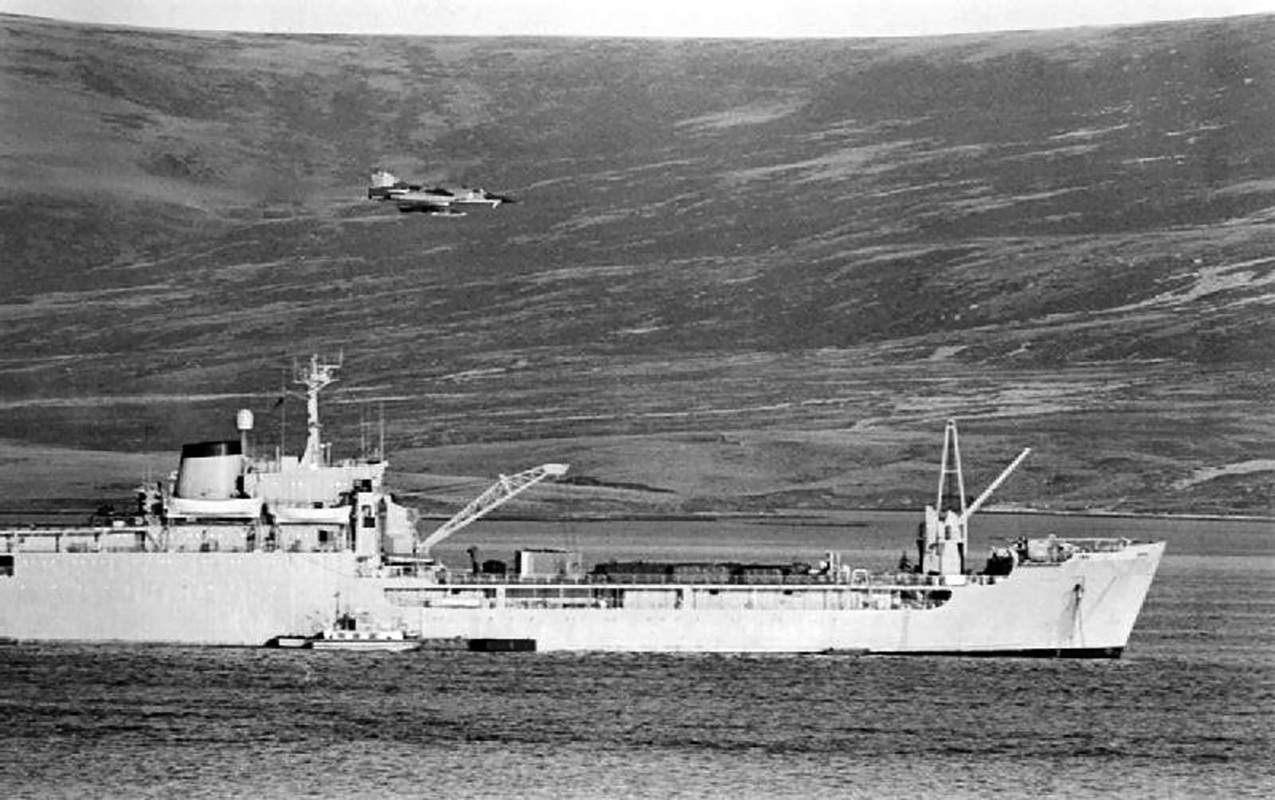
Sources:
Spoiler
Sites:
IAI Dagger
IAI Nesher - Wikipedia
http://misvivenciasenlaguerrademalvinas.blogspot.com/
Books/Magazines:
CPIAyE- Numero 17
DAGGER & FINGER en Argentina - Avialatina
IAI Dagger- Jorge Nuñez Padin
IAI NESHER-The IAF Aircraft series 2
Sea Harrier FRS.1 VS Mirage III/DAGGER- DOUGLAS C. DILDY & PABLO CALCATERRA

























